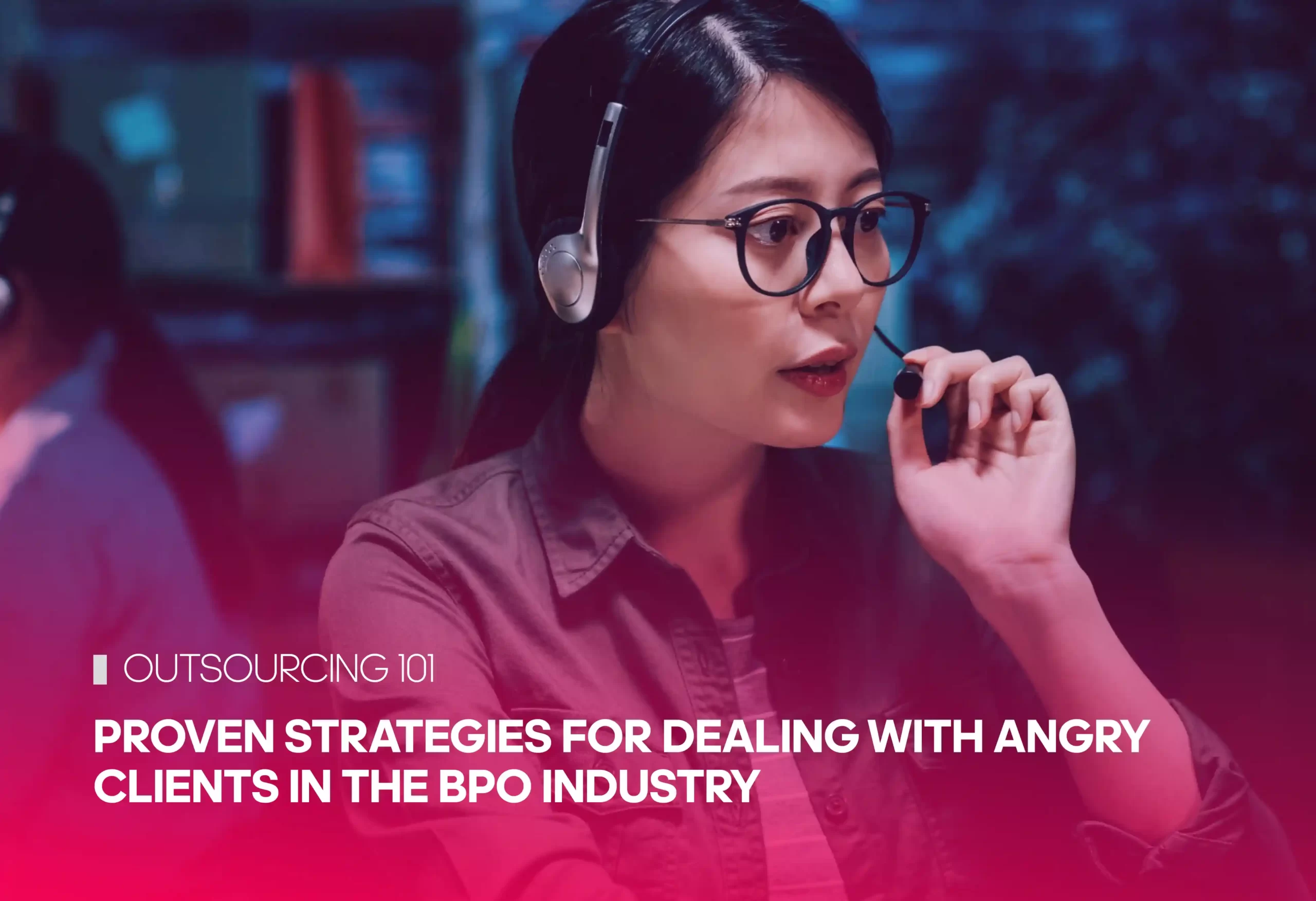In Business Process Outsourcing, client satisfaction is paramount. Maintaining good client relations and ensuring corporate success in the BPO sector need effective management. However, encountering an angry client is not uncommon. How you handle such situations can make a significant impact on the client relationship and overall success of your BPO operations.
Outsourcing operations will be successful in the long run if they prioritize client-centricity and continuous development. Building trust with clients and navigating difficult circumstances are skills that BPOs may acquire by comprehending the root reasons for anger, putting effective communication tactics into practice, and emphasizing prompt issue resolution. In this comprehensive blog, we’ll explore strategies and tips on how to effectively contact an angry client in the BPO industry.

Tips on How to Effectively Deal with Angry Clients
1st TIP: Understanding the Client's Perspective
Before reaching out to an angry client, it’s crucial to understand their perspective. Identify the root cause of their frustration, whether it’s a service issue, miscommunication, or any other concern. This understanding will guide your approach and help you address their specific grievances.
First, understand the emotional surface that angry consumers frequently traverse- from anger to disappointment. Customers invest emotionally as well as monetarily in the services that companies offer. Understanding the emotional cost of their worries can assist service providers in taking an empathetic response to the problem. Then, try to communicate. Anger from clients is frequently brought on by a breakdown in communication. Inaccuracies, imprecise details, or breakdowns in communication may cause clients to feel ignored or underappreciated. By recognizing these communication barriers, service providers may take steps to improve communication, quickly resolve customer issues, and eventually avoid misunderstandings in the future.
Above all, convey your point with empathy. In client interactions, empathy is a very useful technique, particularly when with disappointed clients. You may learn a great deal about the underlying reasons behind your clients’ rage by placing themselves in their clients’ positions. This comprehension empowers providers to react with more empathy and efficiency, showcasing their dedication to attending to the client’s needs.
2nd TIP: Timing is Key
Choose the right time to reach out to the client. Timing can significantly influence the success of your communication. Angry clients often experience a rollercoaster of emotions, ranging from frustration to disappointment. Recognizing that emotions can fluctuate throughout the day is essential. Attempting to address a client’s concerns during a peak emotional moment may lead to escalated tensions and hinder effective communication. Identifying opportune moments for contact is crucial for ensuring that both parties are in a mindset conducive to resolution.
Peak stress periods may be avoided by being aware of the client’s industry, work duties, and potential stressors. Getting in touch with clients while they are stressed out about deadlines or major obstacles might make them feel even more frustrated. Selecting a time when the customer is most likely to be open to conversation should take their schedule and workload into account.
Since customers are usually better rested and haven’t experienced the day’s challenges yet, encounters in the morning may be more fruitful. However, some clients may prefer afternoon discussions after they have had time to address urgent matters.
Moreover, it might be helpful to get in touch early in the week as well since it gives you more time to talk about and work out problems before the weekends. Mondays are favorable for constructive relationships since they are frequently seen as a new beginning.
3rd TIP: Prepare Thoroughly
Before engaging with an angry client, it is imperative to understand the nature of their anger. Anger can stem from various sources, including service issues, miscommunication, unmet expectations, or technical problems. A thorough understanding of the root cause allows service providers to tailor their responses and solutions accordingly.
Customer care agents are the first responders when it comes to handling irate customers. To provide them with the abilities they need to deal with difficult situations, thorough training is essential. This covers skills for resolving conflicts, effective communication, empathy, and active listening. Representatives can be better prepared for real-world situations with the aid of frequent training sessions and simulations. It is essential to establish thorough and unambiguous communication rules. This entails formulating standard replies to frequent problems, specifying appropriate language and tone, and offering directives for when to bring concerns to the attention of upper management. Consistency and professionalism in client contacts are guaranteed by clearly established communication procedures.
Moreover, proactive preparation involves anticipating common issues that might lead to client anger and preparing responses in advance. By identifying potential pain points and developing pre-approved responses, customer service representatives can respond promptly and confidently, demonstrating a commitment to resolving issues.
4th TIP: Choose the Right Communication Channel
Consider the client’s preferred communication channel. While some clients may prefer emails for documentation purposes, others may appreciate a direct phone call. Choosing the right channel can enhance the effectiveness of your communication.
A wide range of communication methods, such as phone conversations, emails, live chats, video conferences, and social media, are used by the BPO sector. Because each channel has its distinct qualities, benefits, and drawbacks, BPO professionals must carefully consider their options before choosing one. Knowing your clients’ preferences is one of the most important factors to take into account when selecting a communication channel. While some clients might value the ease and record-keeping of email correspondence, others might prefer the directness and personal touch of a phone conversation. Building healthy client relationships requires acknowledging and honoring their preferences.
Providing a variety of methods for communicating with customers guarantees adaptability and takes into account their varied tastes. Using this method enables BPO experts to customize their communication plan to the particular requirements of every customer and contact. It is essential to provide BPO agents with the training and skill set required for every communication channel. Strong verbal communication skills are necessary for phone help, while textual communication channels require written expression expertise. Giving agents thorough training guarantees that they can confidently and successfully traverse a variety of channels.
5th TIP: Crafting Your Message
Begin your communication by expressing empathy and understanding. Acknowledge the client’s frustration and assure them that their concerns are being taken seriously. Then clearly communicate the steps you have taken or are planning to take to address the issue. Transparency builds trust and reassures the client that you are actively working on a resolution. Present viable solutions to the client’s problem. If possible, provide multiple options, allowing the client to choose the one that best suits their needs. A sincere apology can go a long way in diffusing tension as well. Take responsibility for any mistakes or shortcomings and express a genuine commitment to improving the situation.
6th TIP: Highlight Future Improvements
The landscape of client service is ever-evolving, and the ability to handle angry clients with finesse is a crucial aspect of success in the business world. As technology, communication methods, and customer expectations continue to advance, it becomes imperative for businesses to proactively identify areas for improvement in dealing with angry clients. Future improvements in client service may involve the integration of predictive analytics to anticipate and address client needs before they escalate into anger. By analyzing historical data, identifying patterns, and employing artificial intelligence, businesses can proactively identify potential issues and implement preventive measures.
Highlight a full and cohesive experience to offer via intuitive systems that smoothly combine several communication channels, such as social media, messaging applications, and upcoming technology. This guarantees that customers may select the most convenient mode of contact for them. Using real-time sentiment analysis technologies can completely change how companies handle irate customers. These systems analyze keywords, tone, and language patterns to give instantaneous insights into clients’ emotional states. This makes it possible to respond specifically to each situation and act quickly to turn bad experiences around.
Outline the measures your BPO is implementing to prevent similar issues in the future. This proactive approach demonstrates your commitment to continuous improvement.
7th TIP: Follow-up
The link between problem-solving and ongoing client pleasure is follow-up. It exhibits a sincere interest in the client’s experience, client-centricity, and a dedication to ongoing development. Follow-up provides irate clients with the comfort that their complaints have been considered and that actions have been taken to avoid future occurrences of the same problems. A timely follow-up recognizes the resolution when a client’s issue is effectively resolved, even if the client is upset. In addition to guaranteeing that the client is informed of the action taken, this correspondence offers a chance to thank them for their understanding and patience during the procedure.
A follow-up is the perfect way to get input on the resolution procedure as well. Businesses may discover development opportunities and obtain important insights into the efficacy of their initiatives by asking for the client’s feedback. Businesses may improve service quality and modify their strategies with constructive feedback. When a client’s expectations are not entirely satisfied, follow-up serves as a forum for resolving any unresolved issues. Open communication regarding unfulfilled expectations enables companies to customize remedies and lessen any residual discontent. The goal of follow-up is to establish lasting connections, not only to resolve issues. Relentless and considerate follow-up cultivates loyalty and trust. Proactive involvement is valued by clients, and follow-up actions help to foster a favorable opinion of the service provider in general.
On A Final Note
Understanding the customer’s point of view is fundamental to handling and resolving conflicts with irate clients in the context of client services. Service providers may skillfully handle difficult circumstances by acknowledging the client’s emotional landscape, resolving communication failures, regulating expectations, and exhibiting empathy via active listening. In the end, a client-focused strategy helps the company succeed in the long run and build its reputation in addition to addressing current issues.
About SPLACE
SPLACE is a dynamic and innovative business process outsourcing company that offers a wide range of outsourcing services to businesses worldwide. With a focus on delivering high-quality solutions, virtual assistance, IT solutions, and exceptional customer service, SPLACE has established the company as a trusted outsourcing and call center service provider to companies across various industries.
SPLACE comprises experienced professionals who deliver customized and cost-effective solutions to meet every client’s business needs. The company believes in the power of technology and innovation to drive growth and success, and its main focus is helping clients succeed in an ever-changing business landscape.
Clients looking for support in data management, customer service, virtual assistance, technical support, or any other outsourcing need can seek help from the SPLACE BPO firm.
If you are interested in Splace’s Business Process Outsourcing Solutions,
Email: ceo@splacebpo.com or call us at
US: +1 929 377 1049 CA: +1 778 653 5218 UK: +61 483 925 479 AU: +61 483 925 479 NZ: +64 9 801 1818
NL: +31 20 532 2142







